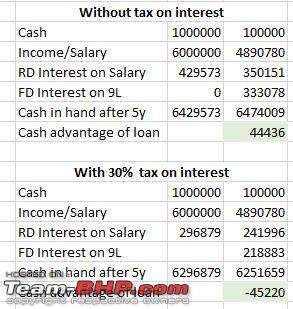| |||||||
| View Poll Results: Have you taken a car loan or gone the full down-payment way? | |||
| Full down-payment | | 304 | 38.19% |
| Couldn't buy without a loan | | 329 | 41.33% |
| Loan taken for any other reason | | 163 | 20.48% |
| Voters: 796. You may not vote on this poll | |||
 |
| Search this Thread |  168,079 views |
| | #181 |
| BHPian Join Date: Apr 2008 Location: Bangalore
Posts: 380
Thanked: 760 Times
| |
| |
| |
| | #182 |
| Newbie Join Date: Nov 2022 Location: New Delhi
Posts: 11
Thanked: 30 Times
| |
| |  (1)
Thanks (1)
Thanks
|
| | #183 |
| BHPian Join Date: Apr 2021 Location: Bangalore
Posts: 218
Thanked: 866 Times
| |
| |  (1)
Thanks (1)
Thanks
|
| | #184 |
| BHPian Join Date: Aug 2011 Location: Pune
Posts: 986
Thanked: 3,889 Times
| |
| |
| | #185 |
| Senior - BHPian | |
| |  (2)
Thanks (2)
Thanks
|
| | #186 |
| BHPian Join Date: Mar 2013 Location: Bangalore
Posts: 235
Thanked: 2,876 Times
| |
| |  (1)
Thanks (1)
Thanks
|
| | #187 |
| Senior - BHPian | |
| |  (2)
Thanks (2)
Thanks
|
| | #188 |
| BHPian Join Date: Mar 2013 Location: Bangalore
Posts: 235
Thanked: 2,876 Times
| |
| |
| | #189 |
| BHPian Join Date: Jul 2014 Location: Bangalore
Posts: 208
Thanked: 332 Times
| |
| |
| | #190 |
| BHPian | |
| |
| | #191 |
| BHPian Join Date: Apr 2008 Location: Bangalore
Posts: 380
Thanked: 760 Times
| |
| |  (1)
Thanks (1)
Thanks
|
| |
| | #192 |
| Distinguished - BHPian  Join Date: May 2007 Location: bangalore
Posts: 3,099
Thanked: 22,347 Times
| |
| |  (10)
Thanks (10)
Thanks
|
| | #193 |
| BHPian Join Date: Jan 2023 Location: Kochi
Posts: 93
Thanked: 282 Times
| |
| |  (2)
Thanks (2)
Thanks
|
| | #194 |
| BHPian Join Date: Sep 2020 Location: Delhi - NCR
Posts: 141
Thanked: 327 Times
| |
| |  (1)
Thanks (1)
Thanks
|
| | #195 |
| BHPian Join Date: Mar 2013 Location: Bangalore
Posts: 235
Thanked: 2,876 Times
| |
| |  (3)
Thanks (3)
Thanks
|
 |
Most Viewed






